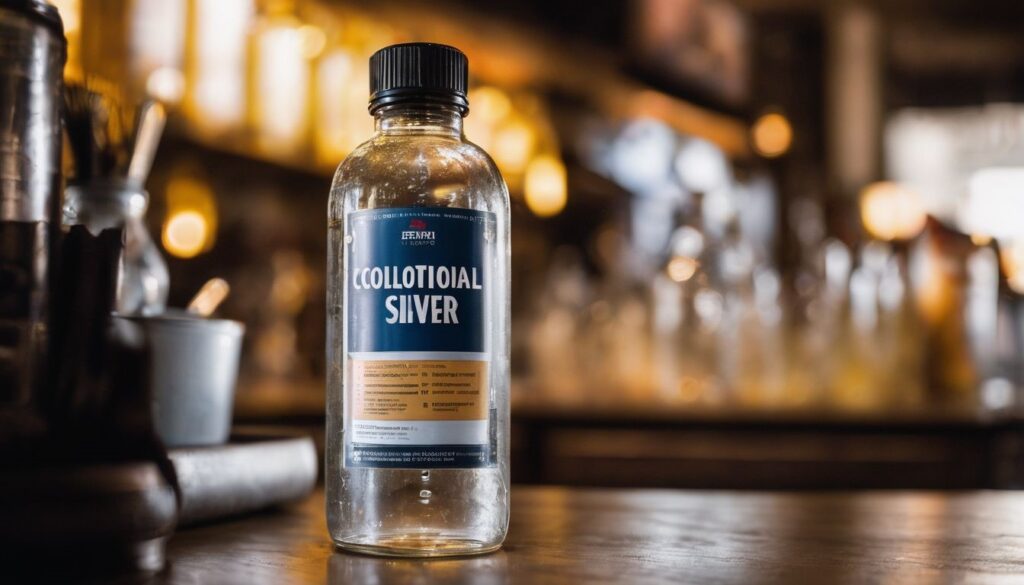Argyria: The Colloidal Silver Blue Skin Condition

Argyria is a rare skin condition where the skin turns blue or blue-grey. It happens when a person has too much silver in their body. People often get argyria from using a colloidal silver liquid, hoping it will improve their health.
But doctors and scientists say that there’s no proof that colloidal silver helps your health, and it can be quite dangerous.
Some people’s whole body turns color with argyria, and for others, just certain parts change. Once the color change happens, it doesn’t go away because the silver stays in the skin forever.
Sunlight can even make the color look stronger.
Groups like the Mayo Clinic and National Institutes of Health tell us not to use colloidal silver because it could hurt our brains and other organs and doesn’t help our health, as some might say.
Let’s explore this unusual condition more together!
Key Takeaways
- Argyria turns skin blue or blue-gray because of too much silver in the body.
- Colloidal silver can cause argyria, and there’s no good proof it helps your health.
- Working with silver or using silver-based products without care can lead to skin discoloration.
- Once your skin turns blue from argyria, it stays forever.
- It’s best not to use colloidal silver to stay safe from argyria. Choose other things that have been proven to work instead.
Symptoms and Causes of Argyria
Symptoms of argyria include blue or blue-grey skin discoloration, which can occur locally or spread across the entire body. This condition is primarily caused by the ingestion or exposure to silver, particularly from colloidal silver products.
Blue or blue-grey skin
Silver can change your skin color if you use it too much. People’s skin turns blue or blue-grey when this happens. This change is the biggest sign of a condition called argyria. It doesn’t happen fast, but slowly over time as silver builds up in their body.
Your skin might start to look gray or bluish if you often touch or eat things with silver. Even parts inside your mouth can turn blue, which looks like another health problem where people don’t get enough oxygen.
But it’s not because of low oxygen; it’s from the silver in their body.
Generalized or local argyria
Argyria can turn skin blue or blue-grey. This happens when too much silver builds up in your body. Sometimes, it changes all skin color; doctors call this “generalized argyria.” Other times, only certain spots change color.
This is “local argyria.” Both kinds come from silver that gets into your body.
If you work with silver or use similar nasal sprays and supplements with silver, you could get local argyria, where the silver touches your skin. But if you eat or drink lots of products with silver over a long time, this might lead to generalized argyria.
Once the silvery color appears on your skin, it often stays there because the silver deposits settle deep in your tissues.
People looking to stay healthy should know about these risks before using any product containing tiny bits of this shiny metal—especially colloidal silver solutions touted for health benefits without strong proof.
Always be careful about what goes on inside your body to avoid unwanted shades of blue!
Silver ingestion or exposure
Taking in silver, whether through eating, drinking, or touching it, can seriously affect your body. It might not seem risky, but too much silver can build up inside you. This buildup can turn your skin a gray or blue color that doesn’t go away.
Some products have tiny pieces of silver floating in liquid, and people might use them to try to stop getting sick. But these items are often the reason why someone’s skin changes colors.
Workplaces with lots of silver dust or using silver nitrate also pose risks. If you breathe in this dust or handle these items without being safe, over time, it could lead to that same strange discoloration of your skin known as argyria.
It’s good to be careful around silver stuff because protecting your health is super important.
Dangers of Colloidal Silver
Colloidal silver poses potential dangers due to the risk of developing argyria, which causes blue or blue-grey skin discoloration. Additionally, there is a lack of evidence supporting the health benefits of using colloidal silver as a dietary supplement.
Risk of argyria
Long-term exposure to silver, especially from colloidal silver products, can lead to a rare condition called argyria. This may cause parts of your body or your skin to turn blue or gray.
Argyria is associated with the dangers of using colloidal silver as a dietary supplement, and it’s crucial to be cautious about using products containing silver particles.
Colloidal silver is often marketed with health claims but lacks substantial evidence for its benefits while posing serious risks such as argyria. It’s important to avoid ingesting or exposing oneself unnecessarily to silver compounds that can lead to this rare and irreversible skin discoloration.
Lack of evidence for health benefits
Research has consistently shown no solid evidence to support the health benefits of colloidal silver. Reputable sources such as the Mayo Clinic and the National Institutes of Health caution against using colloidal silver due to its potential serious health risks, including argyria, neurological damage, and harm to the liver and kidneys.
Furthermore, despite claims about its antimicrobial properties, it’s important to note that supporting scientific evidence for these claims is lacking. Therefore, it’s crucial for individuals interested in improving their health to be cautious of unsubstantiated claims regarding the supposed benefits of colloidal silver.
Understanding the Chemistry Behind Argyria
The chemistry behind argyria involves the build-up of silver in tissues, leading to a blue skin color. This rare condition is caused by ingestion or exposure to colloidal silver products, resulting in microscopic silver particles accumulating in the skin and mucous membranes.
Understanding the biochemical model of argyria sheds light on its permanent nature and emphasizes the importance of avoiding colloidal silver products.
Biochemical model
Scientists have proposed a detailed biochemical model to explain argyria, the condition that turns the skin blue. The model suggests that excessive buildup of silver in the body is responsible for this discoloration.
When silver accumulates, it causes a reaction that leads to bluish pigmentation on the skin. Prolonged exposure to silver, such as from colloidal silver products, can lead to irreversible argyria.
The buildup of elemental silver particles in tissues leads to this unusual color change. As a result, the skin and mucous membranes develop a distinctive shade of blue-gray due to deposits of silver compounds.
Silver build-up in tissues
When silver builds up in the tissues, it can lead to a rare condition called argyria. This excessive accumulation of silver can cause the skin to turn blue or blue-grey. The ingestion or exposure to colloidal silver products is often responsible for this build-up.
Argyria serves as a reminder of the potential dangers of using colloidal silver supplements, highlighting the importance of understanding its risks and avoiding such products.
The build-up of silver in tissues over time due to colloidal silver consumption can have serious consequences, making it essential for individuals interested in their health to be informed about its potential effects.
Blue skin color

Argyria, a rare condition caused by silver or silver compounds exposure, can lead to bluish-gray skin discoloration. This blue skin color arises from the accumulation of silver particles in the skin tissues.
When exposed to silver, especially from products containing colloidal silver ingredients, skin can develop this unique and noticeable discoloration. This serves as a visual reminder of the potential risks of using unregulated supplements containing silver.
The blue skin color resulting from argyria is often permanent, serving as a cautionary sign against colloidal silver products. Understanding the implications of this distinct discoloration is crucial for preventing argyria and safeguarding your health.
Treatment and Prevention of Argyria
Argyria is a permanent condition with no known cure, making prevention crucial. Avoiding colloidal silver products and being cautious around silver exposure can help prevent this rare skin discoloration.
To learn more about the dangers of colloidal silver and how to protect yourself from argyria, continue reading.
Permanent nature of discoloration
Argyria leaves a lasting mark on the skin. Once the silver deposits build up, the bluish-gray discoloration is challenging to reverse. Even though there’s no cure for this condition, it’s crucial not to lose hope.
Protecting your skin from sunlight can prevent further darkening of the affected areas and reduce the intensity of discoloration.
To avoid worsening argyria, stay vigilant about sun exposure and use effective sun protection measures outdoors. While permanent, this condition should not stop you from leading a healthy and fulfilling life.
Importance of avoiding colloidal silver products
Avoiding colloidal silver products is crucial for maintaining your health. These products contain tiny silver particles that can build up in your body over time, leading to a rare condition called argyria.
Argyria causes the skin to turn blue or bluish-grey permanently. Despite claims of health benefits, there’s a lack of evidence supporting the use of these products. The risk of developing argyria outweighs any potential benefits.
Therefore, avoiding colloidal silver products and seeking alternative remedies supported by scientific research is important.
FAQs
1. What is argyria?
Argyria is a rare condition that makes the skin turn bluish-gray because of too much silver in the body.
2. How do people get argyria?
People can get argyria by using products with silver, like colloidal silver supplements, or from breathing in silver dust at work.
3. Can taking colloidal silver cause any problems?
Yes, swallowing colloidal silver or using it in your nose can lead to argyria; there’s no proof it helps keep you healthy.
4. Is there a way to check if I have argyria?
Doctors can tell if you have argyria by looking at your skin and might use a skin biopsy, where they take a small part for testing.
5. Are there many cases of this blue skin problem?
No, cases of argyria are rare but happen when someone takes too much colloidal silver over time.
6. Can doctors fix the bluish color on my skin from argyria?
Argyria doesn’t hurt you, but the blue color usually stays; treatments may help some but do not always change the discoloration.

